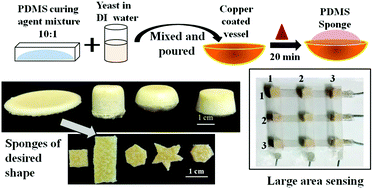Low cost sponge based piezocapacitive sensors using a single step leavening agent mediated autolysis process†
Abstract
In recent years, porous or sponge based elastomers have been considered to be very useful for wearable applications; however, the one step, economical and rapid fabrication of large area porous elastomers is still a daunting task. In this pursuit, we report a leavening agent mediated fabrication of large area, 3D porous polydimethylsiloxane (PDMS) via a rapid (20 min), cost effective and single step method. The leavening agent used decomposes itself during the leavening process by its inherent autolysis property providing a single step method. A unique feature of this method producing highly uniform and robust 3D porous features is that it can facilitate tuning of sensitivity along with obtaining sponges of desired size and shape. The piezocapacitive devices fabricated using these 3D porous PDMS sponges exhibited exceptional sensitivities of 0.756 kPa−1 (in the linear region) and 0.0117 kPa−1 (in the saturation region). These sensors demonstrated an excellent response in small scale as well as large scale motion sensing applications such as pulse pressure sensing, tactile sensing, touch pads, and wrist and palm movements.



 Please wait while we load your content...
Please wait while we load your content...